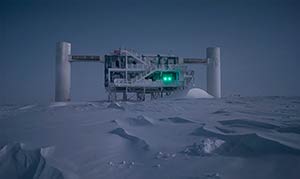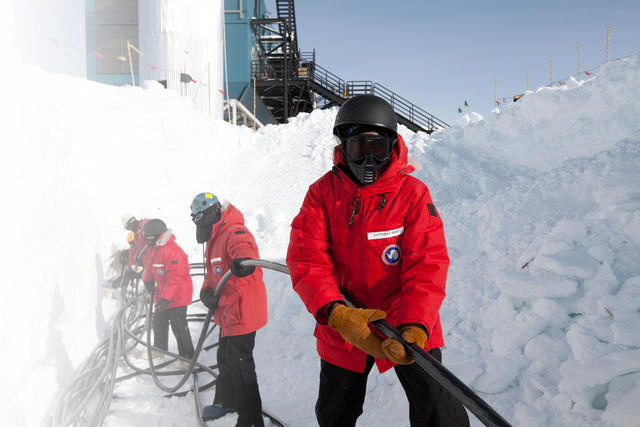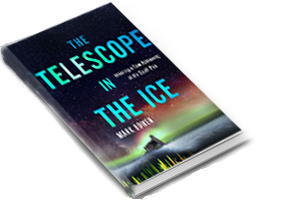





The Telescope in the Ice is about the building of IceCube, which Scientific American has called the "weirdest" of the seven wonders of modern astronomy. It's the inside story of the people who built the instrument, the mistakes they made, the blind alleys they went down, the solutions they found, their conflicts, and their teamwork. It's a success story.
Located at the U. S. Amundsen-Scott Research Station at the geographic South Pole, IceCube is unlike most telescopes in that it is not designed to detect light. It employs a cubic kilometer of diamond-clear ice, more than a mile beneath the surface, to detect an elementary particle known as the neutrino. In 2010, it detected the first extraterrestrial high-energy neutrinos and thus gave birth to a new field of astronomy.
Aside from being a telescope, IceCube is the largest particle physics detector ever built. Its scientific goals span not only astrophysics and cosmology but also pure particle physics. And since the neutrino is one of the strangest and least understood of the known elementary particles, this is fertile ground. Neutrino physics is perhaps the most active field in particle physics today, and IceCube is at this forefront.
The book is mainly about people and the thrill of the chase: the struggle to understand the neutrino ever since it was "invented" by the extraordinary Wolfgang Pauli in 1930, the early researchers who helped understand it, the strange things it taught them about the nature of space and time, and the pioneers and inventors of neutrino astronomy.
"The Telescope in the Ice is a masterpiece of storytelling, bringing to life in rich detail not only the world of science but also the men and women who inhabit that world." — Alan Lightman, author of Einstein's Dreams
"A page-turning chronicle of the decades-long struggle by hundreds of physicists and engineers to create a frontier laboratory for the pursuit of the new discipline of neutrino astronomy. The IceCube Neutrino Observatory at the South Pole has already seen dozens of energetic neutrinos that are likely to have originated somewhere beyond the solar system." — Sheldon Lee Glashow, University Professor, Boston University, and 1979 Nobel Laureate in Physics
"What a wonderful, ever-surprising book. This extraordinary story, about a swarm of smart and often strange people trying to catch some of the universe's smallest particles by turning the South Pole into a giant lens — has found the perfect writer. Bowen, a physicist, climber, and adventurer himself, brings to this tale a mix of knowledge, empathy, clarity, and narrative deftness that brings to mind the great physicist-writer Jeremy Bernstein. Whether describing the tiny, speedy, ubiquitous neutrino (a billion of which just passed through your eyes), the astro-mechanics of a radiant star, the fathomless difficulties of deep-ice drilling, or the unbelieving wonder of the three researchers in the Stitch-and-Bitch knitting club when they look out the window of the South Pole research station and see the first orange rim of daylight after six months of dark, Bowen is the ideal witness, guide, and tale-teller: ludicrously well-informed, always amiable and considerate, and with a born bard's sense of story. He kills even the endnotes, which are, actually, themselves worth the book's price. The book itself is priceless." — David Dobbs, Author of Reef Madness: Charles Darwin, Alexander Agassiz, and the Meaning of Coral (Pantheon, 2005) and contributor to The Atlantic, National Geographic, Nature, and other publications.
"A page turner. I know of no other book that does such a wonderful job describing the fun, creativity, and resourcefulness required to do great experimental science." — Katherine Freese, George E. Uhlenbeck Professor of Physics, University of Michigan and Guest Professor of Physics, Stockholm University
"The heroic days of exploration are definitely not over. These scientists haul thick hoses across the ice cap and sleep — when they do sleep — in thin huts with a tin cup for a toilet. Back home they fight off a self-serving Nobel laureate and petty agency head who maneuver to take their project away from them. If you want to know how science really works, this is your book. It ain't always pretty, but when it works — wow. They have made one of the biggest advances in astronomy since Galileo." — George Musser, contributing editor at Scientific American and Nautilus, and author of Spooky Action at a Distance
"This is a major work in many ways, I think, not only a compelling tale, a humane science history, but an inspiring picture of how great science gets done (or not). Bowen reports from the inside on the decades long struggle to record cosmic neutrinos, and not only do we see it finally realized, but with neutrinos once again not behaving as expected, pointing to new mysteries of the cosmos. Having been a losing player in this long science game, my hat is off to the tough team who have pulled off one of the great physics experiments of all time." — John G. Learned, Professor of Physics, University of Hawaii, Manoa